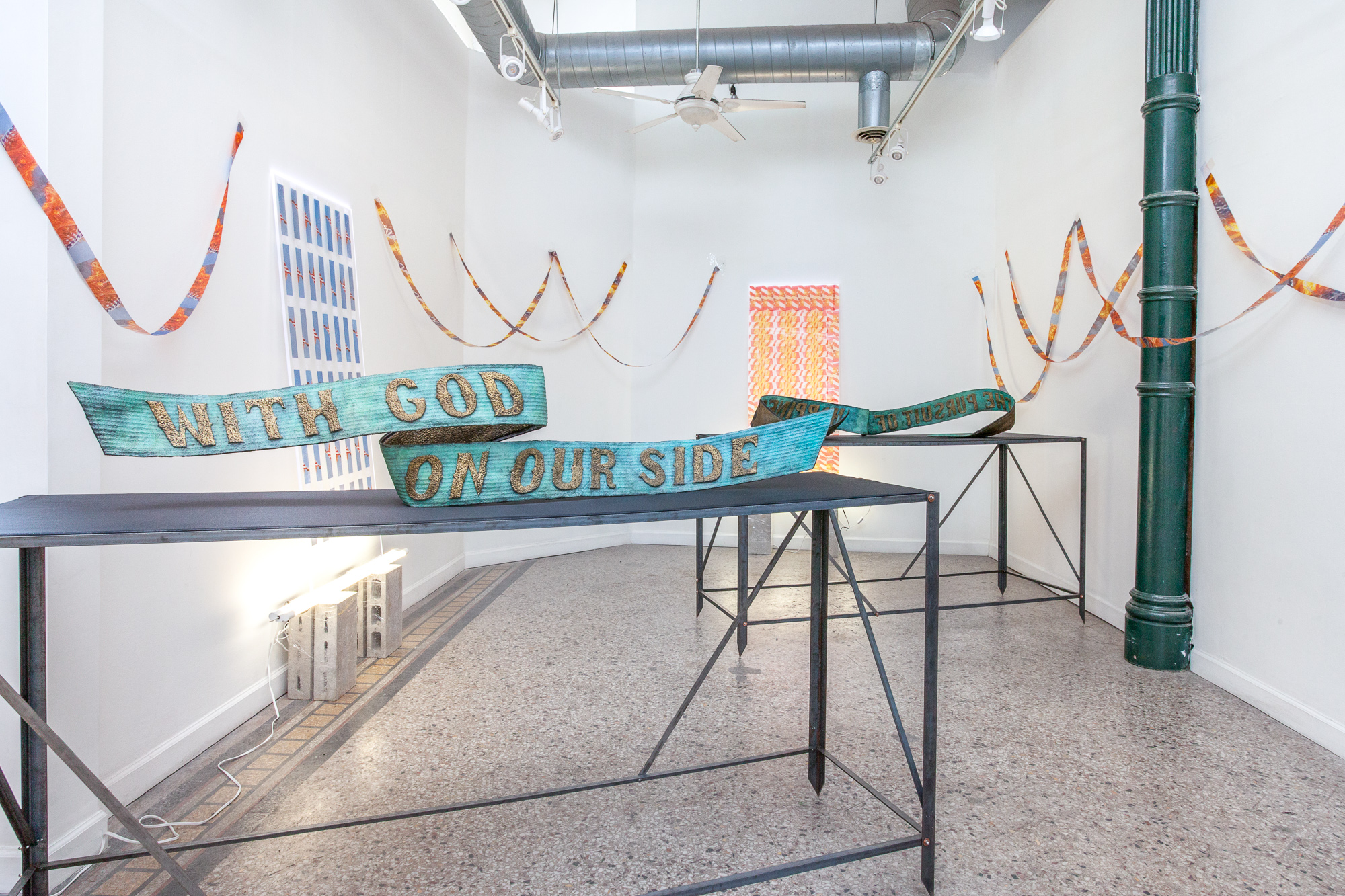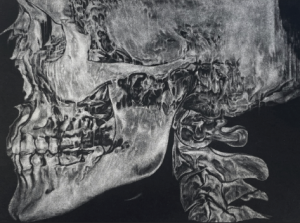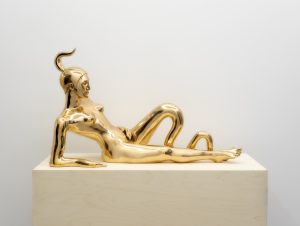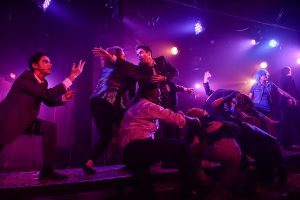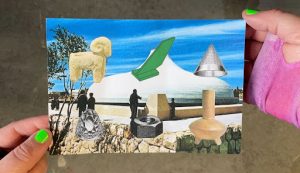In our current moment, Chicago’s artists and creators find themselves exhaustingly entrenched within the gig economy, where artist-run spaces and projects commonly exist in liminal zones of financial and programmatic instability. Neoliberalism’s acceleration has only illuminated how the endeavor to make and create within the art economy is demarcated by racism, classism, and technological isolation, i.e. the art world’s role in gentrification, the exclusionary cost of many MFA programs, the growing scarcity of funding, and the fleetingness of social capital within the attention economy. Uncertainty and anxiety permeate our current moment; we live in a constant state of reckoning. How can one meaningfully create and work while maintaining a constructive and reparative critique of one’s own complicity within systems of oppression? In a maze of disenfranchisement, how can the art world be a roadmap for advocacy? Is such a change even possible?
I do not know the answers to these questions. However, I do believe that there is something––a hint, a clue, a discovery––to be uncovered within an examination of time and how it has shaped us, for better or worse. How have we met the changes that have formed the years since the early aughts? Where can we go in 2020 and beyond? I shift the focus of my questions to artists and arts communities in order to illuminate how we have met scarcity and continue to face our own complicity and investment in inequality. It is through this people-powered lens that I intend to explore the growth, resilience, and advocacy of the makers and thinkers of this city. I intend to delve into how Chicago’s ecosystem of art and artists has changed over the last decade. Where are we now, where have we been?
In order to understand this interplay of time, anxiety, change, and art, I spoke to Eric May of Roots & Culture and Alden Burke and Stephanie Koch of Annas about the struggles, successes, trials and tribulations of their spaces. Roots & Culture has been a part of the Noble Square and West Town communities for more than a decade, and Annas is heading into their second year of programming and artist residencies in Pilsen. I asked May, Burke, and Koch the same questions as a means to pinpoint moments of interchange, convergence, and divergence between Roots and Annas. I hope that providing a forum for two spaces at different moments within their lifetimes depicts how artists in this city have met, critiqued, and overcome the challenges we face. As I hope for the artists’ words to speak for themselves, it is my intent for the conversation below to embody the generosity and reciprocity of Artists Run Chicago. It is also my hope that this piece illustrates how their respective vision, creation, and determination are what give this city its beating, achingly alive heart.
Annette LePique: How do you create and conceive of Roots & Culture’s multi-faceted approach to programming: the CONNECT and Double Exposure proposals, alongside exhibitions and openings? How has the process changed in the last ten years?
Eric May: CONNECT is the older of the two programs, though has also evolved the most. In our earliest days (2006-2007) I did most of the curating, though I felt that it would be appropriate to mix things up and invite outside curators to propose shows, so that was our first submission-based program. And for the most part, it simply ran like that for about eight years. Emerging curators would propose shows and we’d run one or two of them per year.
There’s an apartment in the mezzanine space above the kitchen, where I lived until 2014. When I moved out, this opened up the opportunity to run a residency, which is something I had always considered in the back of my mind. So we re-imagined CONNECT as a summer curatorial residency, which kicked off in 2016. After the 2017 season, our programming committee evaluated who the residency was serving; the first two residents were both women of color. And taking into consideration the current moment of assessing representation and equity, we identified a need to prioritize opportunities for historically underserved people.

Double Exposure was launched at the onset of 2008 when we were granted our nonprofit status and began behaving more like a proper institution, establishing a board of directors and mission-specific programming. Serving emerging artists has always been our focus and we saw a lack of high profile opportunities for artists at this stage of their careers (though we like to keep the term “emerging” as inclusive as possible and not discriminate by age or educational background). Group shows seemed to be the springboard for many early career artists– which can be great, but are often confined by space limitations and the conceit of the curator. So we wanted to offer something meatier. On the other hand, we liked the idea of the dialogue that happens when bodies of work are shown in proximity to one another. So the answer was a two-person exhibition series.
We admit both proposals from pairs of artists who have chosen to submit together and also solo submissions that our programming committee matches up. We really like the range of possibilities that happens with this flexibility– the duos that apply are often more collaborative, but we also like the tension and contradictions that happen when we bring two artists together who may be unfamiliar with each other’s work.
AL: What are some challenges, learning experiences, and successes Roots & Culture has encountered over the last ten years? How do you envision R&C within the cultural landscape of Noble Square and Chicago?
EM: Ugh, of course the major challenge is always money. Receiving our 501(c)(3) status the same year as the market crash was a tough one. Even in the current (supposedly) strong economy, it doesn’t seem like foundations and government agencies have rebounded funding to a bygone era of robustly funded small to medium organizations. We’ve had to rely mostly on the generosity of our community to stay afloat– to this day our spring benefit and individual donations account for 75% of our revenue. On one hand, it’s never enough to do everything we’d like to, but on the other, its heartwarming to feel so loved!
I’ll never live down when Martine Syms called us the “suburban basement of the Chicago art world”, and now I can admit she was right. The vision I had for the space was always “community-centered”, but for our first few years that meant my immediate social circle, which was mostly white dudes chugging beer and slamming chicken wings after hours. But our constituency opened up as we started to accept proposals and grew our reach. Now I make friends through the program rather than make programs for my friends. These days, I like to think we serve as a welcoming hub and a significant giver of opportunities to the Chicago emerging art community.

In terms of the neighborhood, Noble Square is funny. It’s only like four blocks by three blocks. The Milwaukee Avenue corridor and West Town area have long been home to art spaces, and I see us as a part of a rich history.
AL: How has gentrification impacted your space and programming? How has Roots & Culture negotiated being both a communal space and, like all cultural producers, a potential agent of the gentrification process? How do you navigate those challenges?
EM: I can’t say that gentrification has impacted us, per se. I mean the rental market has gone up in the neighborhood, but from our relatively privileged position, it has not impacted us to the point of discussing relocating or anything.
I think about how we might contribute to gentrification though. The gallery is located on a commercial corridor with a 40-year history of being home to DIY art spaces. We chose this location intentionally. Of course, we have neighbors though, and a lot of them are fancy condo developments. However, much of the east side of Milwaukee, from the highway up to Division, is a housing cooperative that dates to 1970, with many original occupants. Its a largely African American community. I can admit that we have not done enough to welcome them into the space. For several years, my friend, artist Mike Wolf lived in the basement at R&C as he was working on his second show at the gallery “Hey, We’re All Beginners Here.” Part of the mission of the show was an effort to increase accessibility to the space, including for the immediate neighbors. He offered open mic events that were pretty successful at engaging folks from the coop. I lament that we haven’t been able to carry Mike’s torch with his project. This is a lame excuse, but we just don’t have the human resources to establish and maintain outreach with the coop’s community. We need another Mike Wolf!

We largely chose our neighborhood for its centrality and accessibility to public transportation and major roads, so that we could be accessible to wide ranging communities. Our demographic is not neighborhood specific, but rather a community of shared culture, interests, and values.
I honestly believe that most of the art economy is complicit in gentrification. A significant and dominant demographic of the art world, middle to upper class people with art degrees, has the privilege to pursue this precarious career path. And whether seeking an “authentic” artist lifestyle or limited by scarce paychecks, many artists look for affordable rents in lower income neighborhoods. But it was ultimately a choice for most artists to live in these neighborhoods, while many folks who live there did not have that choice.
I’d like to think that the work we do at Roots at least suggests an alternative, redistributive model to the insecurity of the art economy– offering artists career-boosting opportunities and straight up cash for their labor. We hope to provide a model for a more equitable, sustainable art economy, and we know we have more work to do. In a broader vision of this world, maybe artists can find more flexibility and thoughtfulness in their housing choices.
AL: Where will Roots & Culture go from here? What’s next?
EM: After 13 years, our program is running pretty smoothly. We always hope to provide more resources to artists– I’d love to double our stipends. And offer professional services and mentorship, like regular studio visits. If we had more staffing resources, I can envision more shoulder programming like regular artist talks and community discussions. We hope to keep on keeping on for at least another 13 years!
Annette LePique: How do you both create and conceive of Annas’ multi-faceted approach to programming: the collaborative residences, events and happenings rooted in community building practice, and other ongoing programs alongside Annas’ exhibitions and openings?
Alden Burke: When conceiving Annas, Stephanie and I wanted the space to be a living, breathing representation of what we are curious about: collaborative making through flexible, process-based structures. That meant creating a multifunctional concept that unfolds and responds to what we learn during any program that Annas works on. To achieve this, we consider Annas as a site, as a collective, and as a person.

As a site, the spatial design of Annas is malleable, and transforms to the needs of its program. It is both studio and gallery, dining room and institution. As a collective, Annas is a growing network of collaborators, each of whom expand what Annas might be through their own capacity to imagine, produce and facilitate what Stephanie and I never could. For example, the focus on intimacy building over dinners grew out of the first cohort (Caroline Dahlberg, Mariel Harari, Azalea Henderson, and Maggie Wong), iterating on what a collaborative exhibition looks like started with The Overlook (Jenn Sova and Graham Feyl), and evolved with Flatland (Curt Miller and Chris Reeves). The arm of pop-up programs materialized with Doodle Jam (Logan Kruidenier) and will continue to evolve in 2020.
Lastly, we like to think of Annas as a person in itself. To us, Annas is someone who constantly finds inspiration and energy in the people they are surrounded by; someone who wants to invite friends into their home and get to know each other over dinner. But Annas is also someone who is curious and eager to explore the communities and happenings in Chicago. Annas is someone who wants to learn from new environments, contexts, and expertise.
For Stephanie and I, a driving programmatic philosophy during this whole process is to listen to Annas and let the space tell us what is possible, what can be challenged, and who to reach out to along the way.
AL: What are some challenges, learning experiences, and successes Annas has encountered over the last year? How do you both envision Annas within the cultural landscapes of Pilsen and Chicago?
Stephanie Koch: A lot of what Alden and I think about are the constraints that make artistic production difficult, particularly for emerging makers, and how to think of those constraints as generative and as prompts: lack of funds, supplies, and studio space; maintaining energy and creativity while balancing multiple hustles and everyday stress and relationships; time management, as in dedicating time to an ideal of productiveness. Those challenges we recognized in artists and from which we created Annas, manifested in their own versions as challenges that we’ve faced in our first year, like budgeting and funding, not overextending ourselves, and checking in and communicating expectations between each other, our residents and collaborators.
Directors of independent spaces know the drill. Because of the innate scrappiness of the project and the low to no funds, you’re the director of the space, but you’re also the social media intern, custodian, accountant, bouncer, manager of development, art handler and preparator, etc. You wear all the hats. And additionally, by nature of what Annas is, that is self-reflexive, improvisational and focused on attending to the human-scale. We’re constantly evaluating, responding and rebuilding. That requires a level of energy and attention that if we’re not careful, of ourselves and each other, we can burn ourselves out. And we have burned out a few times. We took a month off to rest when that happened. We don’t have a regular calendar or administrative infrastructure that could add some ease. There are some constants, like the physical space and our values, but for each program or residency cycle, a lot is built from scratch.

Image: a yolk, suspended installation view at Annas, July-August 2019. Abstract objects and text-based work sit on a white table in the center of the image. The walls are bare except for a dripping cascade of autumnal greens, ochres, maroons, blues, and greys painted on wall to the right. Photo courtesy of Annas.
Of course, Annas faces the challenges that all art spaces face like money, time and womanpower. But on an everyday level of what that looks like, and how crazy our schedules can get when we both also work a regular 40-hour week job, and every night has some kind of meeting, studio visit or program for Annas, and two friends have exhibition openings this weekend and we want to be supportive and attend all of those, but then Annas’ walls need to be repainted before Sunday so we can be on time for our exhibition install and now Annas has a leak that is squidging out a mysterious thick, brown liquid onto our freshly-painted wall, and I need to call my mom back, and Alden is moving into a new apartment, etc etc etc., our biggest challenge folds into what has been a great learning experience, which is remembering to take care of ourselves and each other, and how that needs to be a priority, so we can hold and take care of others.
This last year has also been a self-directed crash course in arts administration. When Alden and I conceived of Annas, we reached out to directors of spaces that did great work like Roman Susan, Candor Arts, ACRE, The Overlook, Public Access, Experimental Sound Studio and others to learn from their experience and how and why they built the spaces they did. Beyond the practical knowledge we gained from them, we learned and continuously appreciate the generosity of the Chicago arts community, and that seems uniquely a Chicago spirit. Every person we reached out to was very generous and supportive, and more often than not became a friend. We learned that those informal moments shared over a coffee or a beer are not only informative but nourishing, and encouraged us to keep moving and be creative, so we tried to fold that spirit into Annas’ values.

Image: The Waves installation view at Annas, August–September 2019, featuring artists Rohan Ayinde, Cameron A. Granger, and Joshi Radin. Image-based works are installed on three white gallery walls. A text-based work is reflected on the back wall with a light. Photo courtesy of Annas.
Annas’ name comes from a similar informal moment. When Alden and I began talking about our space, we were more acquaintances, and one day in between meetings while casually chatting we discovered that both of our closest friends are named Anna. And that was a wonderful connection moment where, if I can be cheesy, it felt like a deeper friendship began. So the name commemorates that moment, points to an intention to create similar moment between makers, and is also a feeling. When each of us go to our Anna’s home, it is a place to be ourselves, to be vulnerable, to be creative in unexpected ways, to explore, and to feel supported and understood. And we aim to foster those feelings for anyone that comes to Annas.
Beyond the opportunities that we’ve been able to build for ourselves, when a job market is not as providing as we’d like, the greatest success is the affinities between the first cohort of residents. Caroline, Mariel, Azalea and Maggie didn’t know each other when their residency started, and throughout and at the end, to see the amount of love, trust and creativity between and within each member was amazing and truly indescribable. When Alden and I shared the meaning of Annas, the cohort said they felt we definitely accomplished what we set out to do and they felt those feelings we created at Annas through conceptual and practical infrastructure. So our greatest success is not only that we fulfilled our intentions, but that we did so in a way that created meaning and lasting relationships for others.
AL: How has gentrification impacted your space and programming? How does Annas negotiate being both a communal space and, like all cultural producers, potential agents of the gentrification process? How do you both navigate those challenges?
AB: This is something we’re regularly grappling with: who is Annas for? Starting Annas right after both finishing grad programs, our immediate community to work with and from was one that makes up a good chunk of Chicago’s art world: artists with graduate degrees, a lot of whom are coming out of SAIC. While this network has been invaluable to shaping Annas, we have to continually remind ourselves to step outside the circles we know — and this takes time, because it’s easy to pull from the incredible artists immediately around us.
Being located in Pilsen further complicates the question of who Annas is for. We inherited our space from Prairie Gallery (now on Cermak near Damen), moving into an industrial building filled with artists. The place was ideal for us because (a) it has an art space history so people knew where it is, (b) it is affordable for the two of us to pay rent — $420 total, plus utilities, (c) it is near public transportation, and (d) it is within walking distance of several other new or deeply established art spaces — ACRE, Lithium, Baby Blue, Chicago Art Department, to name a few. For us, especially being so new, running a space in Pilsen was a huge asset, and we felt a sense of comradery and alignment with the affiliated neighborhood spaces that was important for us as we were learning what Annas might be.
But now with a year of experience, we’re starting to peek our heads out of the 600 square foot tunnel we’ve lived in for the first year, and are, with greater focus, considering the larger landscape(s) that Annas operates with/in, and strengthening the relationships we have with our Pilsen neighbors, art spaces or otherwise.
AL: Where will Annas go from here? What’s next?
SK: “Here” is an interesting word for Annas. Our foundation is based on three points: exhibiting process, creating structures to support collaboration, and foregrounding vulnerability and empathy. But the rest of Annas’ architecture, conceptually and practically, is flexible and constantly moving, and that flexibility is intentional, so that we’re always responding to the people and work in front of us, and creating the structures (programming, administration, exhibitions, publications, etc.) from there. So, to think of Annas’ “here,” our current place from where we’re going, is interesting because our “here” is constantly shifting and contingent and our movement from “here” is thoughtfully improvised. And we find that place to be really generative. During our last meeting, Alden and I talked about how much we’ve been able to accomplish in the last year, and how many people became friends and collaborators, beyond what we could visualize and plan, and to think of where we’ll be this time next year feels impossible to imagine, in a really exciting way.

But that’s a roundabout answer. We have a calendar and plan for 2020, and within that we held space for collaborative opportunities and potentials that may come our way. And when creating that calendar, we discussed questions within Annas’ values (collaboration) and in our personal practices (for Alden, educational models and syllabi as a studio practice, for me, institution-building as a curatorial practice) that we want to explore, and how can we fold that into our 2020 year. In the short-term, we’re focusing on our 2020 residency (to begin in mid-January and run through July) and thinking through and with the six residents: How can collaboration hold across distance? And we’re doing that work through a syllabus beginning with the simple question of “What is reading? What is writing?” Annas’ residency is a way for Alden and myself to practice what we’re individually interested in, interleaving with the interests and works of our residents.
When Alden and I started Annas we decided on a few values that were, and continue to be, important to us, but also let Annas tell us what she wanted to be. For a moment, it seemed like gallery, then a project space, and now it seems to be a residency. But considering that our residents are Chicago-based, what does it mean to be in-residence in your home and everyday life? Annas’ form seems to be moving naturally toward becoming a kind of school (school in the gooiest sense) predicated on empathy, human-scale, and horizontal knowledge production. Annas might be settling into her final form or it might move into another kind of shape.
Long-term, we’re thinking through scale. And not so much a hierarchical scale with a capitalist impulse, such as scaling up what we do at Annas and making Annas bigger and an institution in the traditional sense. But scaling out and with. There are so many other people who are thinking through learning, (arts) education, and other forms of pedagogy in creative ways. Focusing on Annas’ value of collaboration, we’re working on how to scale out the methods and intentions of what we do at Annas, bring that into other spaces and inviting others to come into ours, and have it co-mingle with the work that other makers and small arts organizations who are also thinking about other forms of learning and togetherness. 2020 is about scaling out and with.
Featured Image: Installation view of (Dis/Re)membering the Empire exhibition at Roots & Culture in February 2018, featuring work by Liz Ensz and Ivan LOZANO. In the foreground, a sculptural piece in the shape of a starched turquoise banner readers “With God On Our Side”. Multicolored ribbons are pinned on the left, right, and back walls; they loop downward in large waves. A blue and orange print in a geometric pattern of repeated rectangular shapes hangs above a light on the left wall. Another geometric print hangs in the background; repeated undulating orange lines dominate the design. A second sculptural turquoise banner sits on a table near the back, its text partially obscured. Photo courtesy of Roots & Culture.
Editor’s note: This article recently appeared in Lumpen 137, and is being cross-published here as part of Sixty’s partnership with Hyde Park Art Center and Public Media Institute in producing the exhibition publication for Artists Run Chicago. The exhibition continues at Hyde Park Art Center until November 1. More info can be found here.


Annette LePique is an arts writer, educator, and archivist. Her research interests include cinema, race, illness, and the body. She has written for Cleo Film Journal, Another Gaze Feminist Film Journal, and Dilettante Army.
